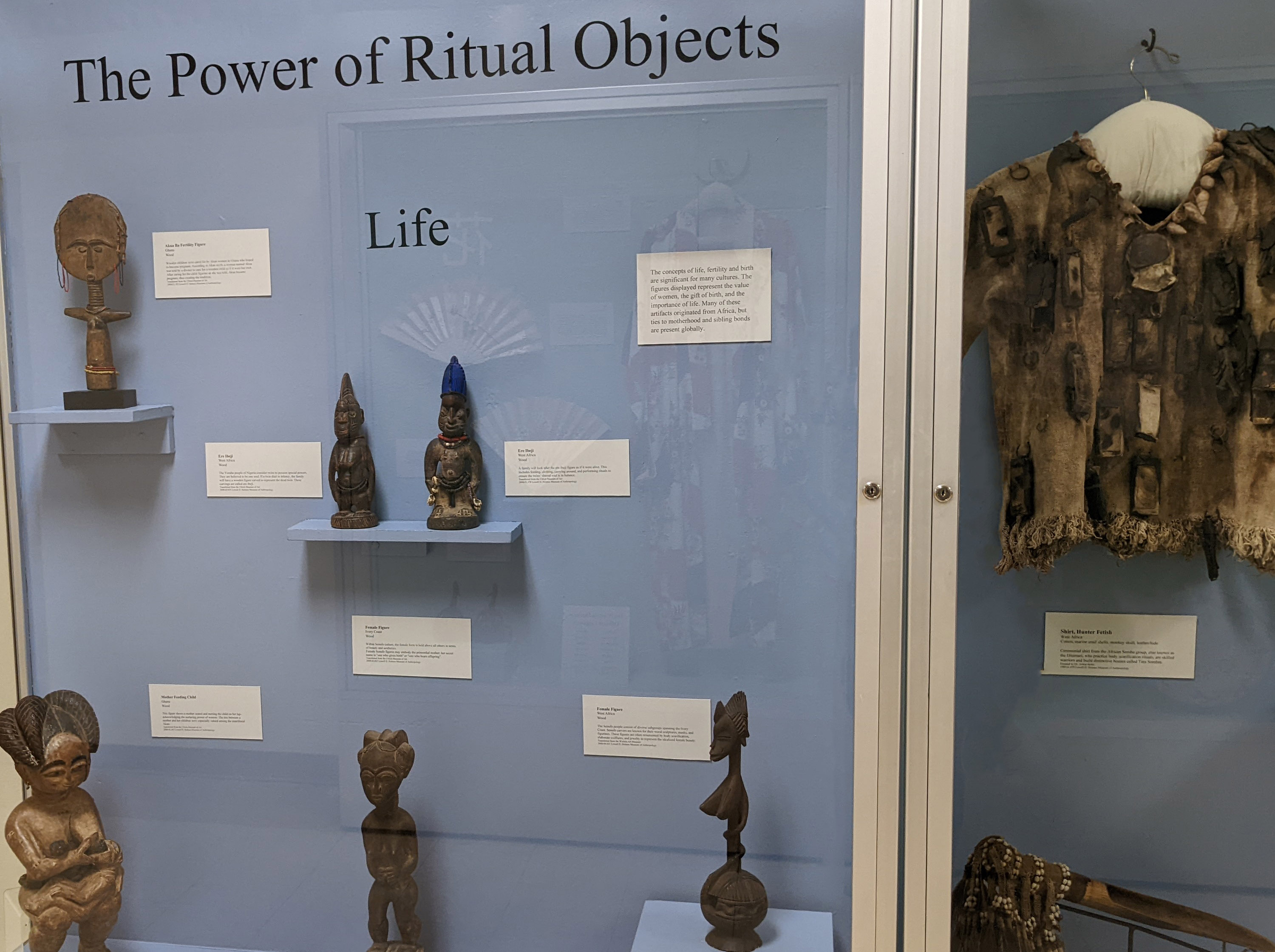The Power of Ritual Objects
The exhibit "The Power of Ritual Objects" was designed and created by the following students in the Museum Exhibition Class Spring 2022
Student Preparers
Morgan Markley, Jordan Larzalere, and Suzannah Guthrie
Museum Staff
Instructor and Museum Director: Rachelle Meinecke
Museum Staff: Gracie Tolley, Ria Morgan, and Angie
Life
The concepts of life, fertility and birth are significant for many cultures. The figures displayed represent the value of women, the gift of birth, and the importance of life. Many of these artifacts originated from Africa, but ties to motherhood and sibling bonds are present globally.
Akua Ba Fertility Figure
Ghana
Wood
Wooden children were cared for by Akan women in Ghana who hoped to become pregnant. According to Akan myth, a women named Akua was told by a diviner to care for a wooden child as if it were her own. After caring for the child figurine as she was told, Akua became pregnant, thus creating the tradition.
Transferred from the Ulrich Museum of Art
2008.02.383 Lowell D. Holmes Museum of Anthropology
Era Ibeji
West Africa
Wood
The Yoruba people of Nigeria consider twins to possess special powers. They are believed to be one soul. If a twin died in infancy, the family will have a wooden figure carved to represent the dead twin. These carvings are called ere ibeji.
Transferred from the Ulrich Museum of Art
2008.02.035 Lowell D. Holmes Museum of Anthropology
Era Ibeji
West Africa
Wood
A family will look after the ere ibeji figure as if it were alive. This includes feeding, clothing, carrying around, and performing rituals to ensure the twins’ shared soul is in balance.
Transferred from the Ulrich Museum of Art
2008.02.378 Lowell D. Holmes Museum of Anthropology
Mother Feeding Child
Ghana
Wood
This figure shows a mother seated and nursing the child on her lap- acknowledging the nurturing power of women. The ties between a mother and her children were especially valued among the matrilineal Akan.
Transferred from the Ulrich Museum of Art
2008.02.382 Lowell D. Holmes Museum of Anthropology
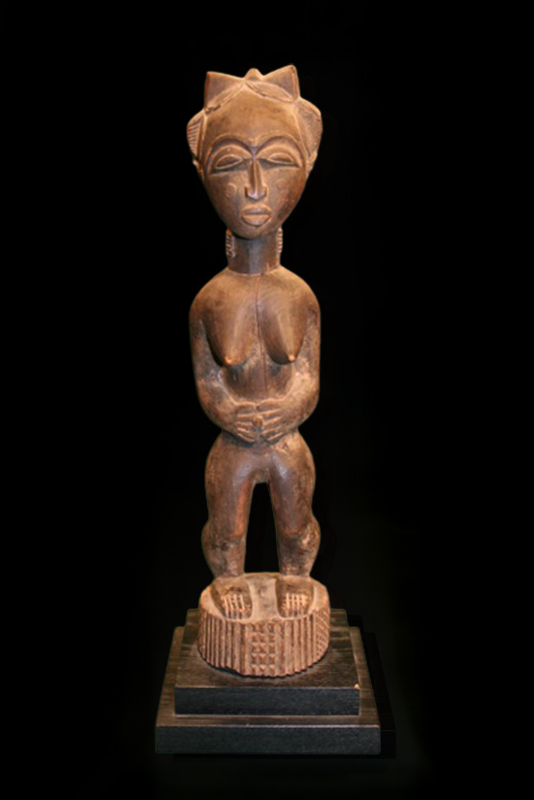
Female Figure
Ivory Coast
Wood
Within Senufo culture, the female form is held above all others in terms of beauty and aesthetics. Female Senufo figures may embody the primordial mother; her secret name is "one who gives birth" or "one who bears offspring.”
Transferred from the Ulrich Museum of Art
2008.02.065 Lowell D. Holmes Museum of Anthropology
Female Figure
West Africa
Wood
The Senufo people consist of diverse subgroups spanning the Ivory Coast. Senufo carvers are known for their wood sculptures, masks, and figurines. These figures are often ornamented by body scarification, elaborate coiffures, and jewelry to represent the idealized female beauty.
Transferred from the Wichita Art Museum
2000.04.023 Lowell D. Holmes Museum of Anthropology
Hunt
Ritualistic objects and weapons associated with the hunt are found in numerous cultures on every continent. The objects displayed here range from hunting tools and weapons used for ritual purposes and hunting animals, to weaponry used in human head-hunting ritual and practice.
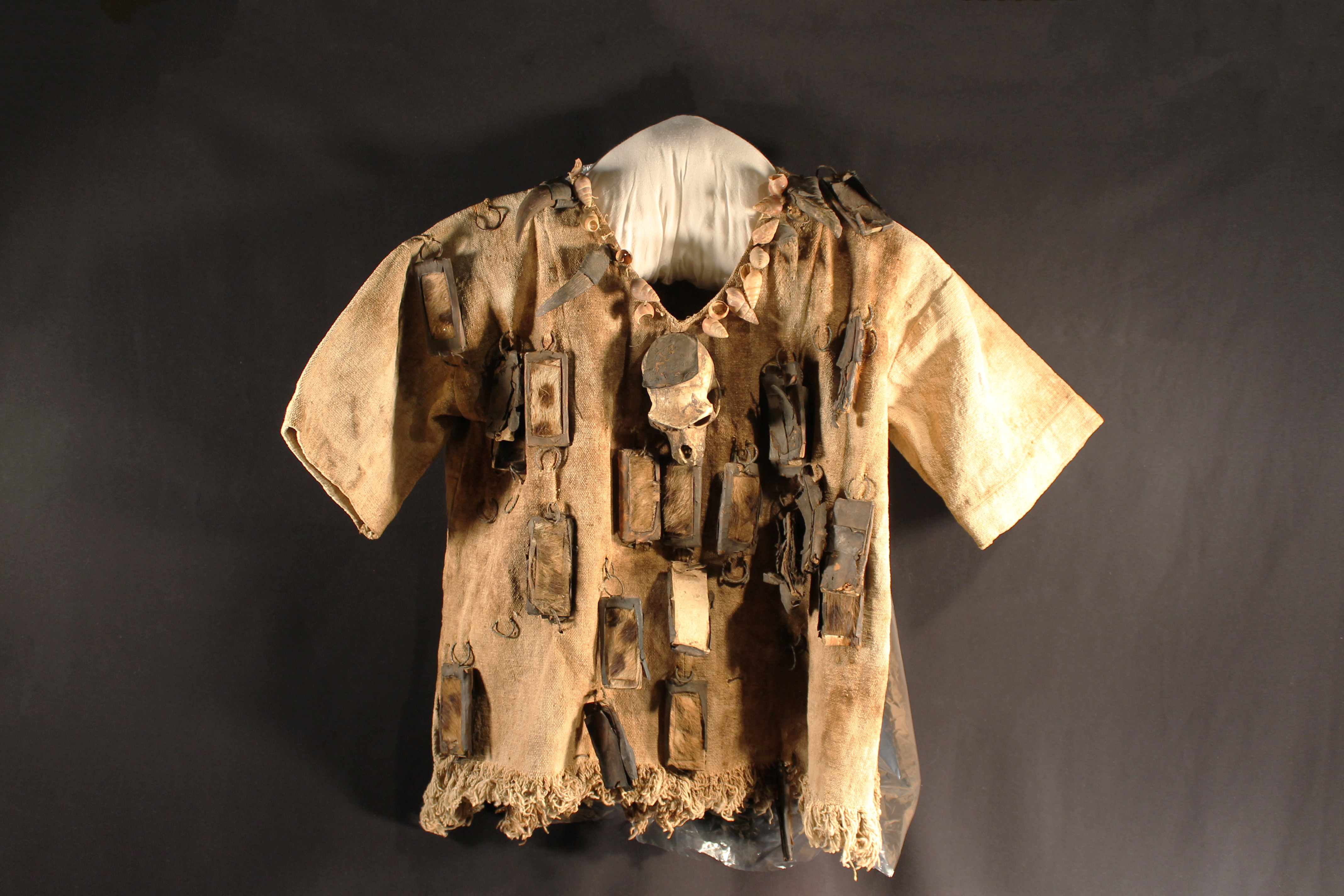
Shirt, Hunter Fetish
West Africa
Cotton, marine snail shells, monkey skull, leather/hide
Ceremonial shirt from the African Somba group, also known as the Ditamari, who practice body scarification rituals, are skilled warriors and build distinctive house’s called Tata Sombra.
Donated by Dr. Arthur Rohn
1989.01.039 Lowell D. Holmes Museum of Anthropology
Object Description: Cotton pullover short sleeved shirt with fringed bottom. Marine snail shells line the V-neck, a monkey skull in the middle, leather/hide pockets dangling off the shirt and shirt has been very well used consisting of sweat stains and dirt
Head-Hunting Axe
Philippines/Asia
Metal axe head, vegetal fibers, wood, red and green beads.
Headhunting was historically a practice used by certain indigenous tribes as a ritual or ceremonial practice often involving severing the head or other body parts of rival tribal members. Headhunting did not always result in the act of cannibalism and was often a source of achievement in hunting, proof of manhood or a show of prestige.
Donated by Rev. Leonard A. & Mrs. Dale Sr.
2015.06.029 Lowell D. Holmes Museum of Anthropology
Olla
Southwest USA/North America
Clay pottery, red and black on cream
Heartline deer motif, traditionally made by Zuni Pueblo women. Relatively large vessel used for collecting, carrying and storing water. The heartline symbol is represented as the life force of the animal
Donated by John A. (Jack) Morgan
2002.04.061 Lowell D. Holmes Museum of Anthropology
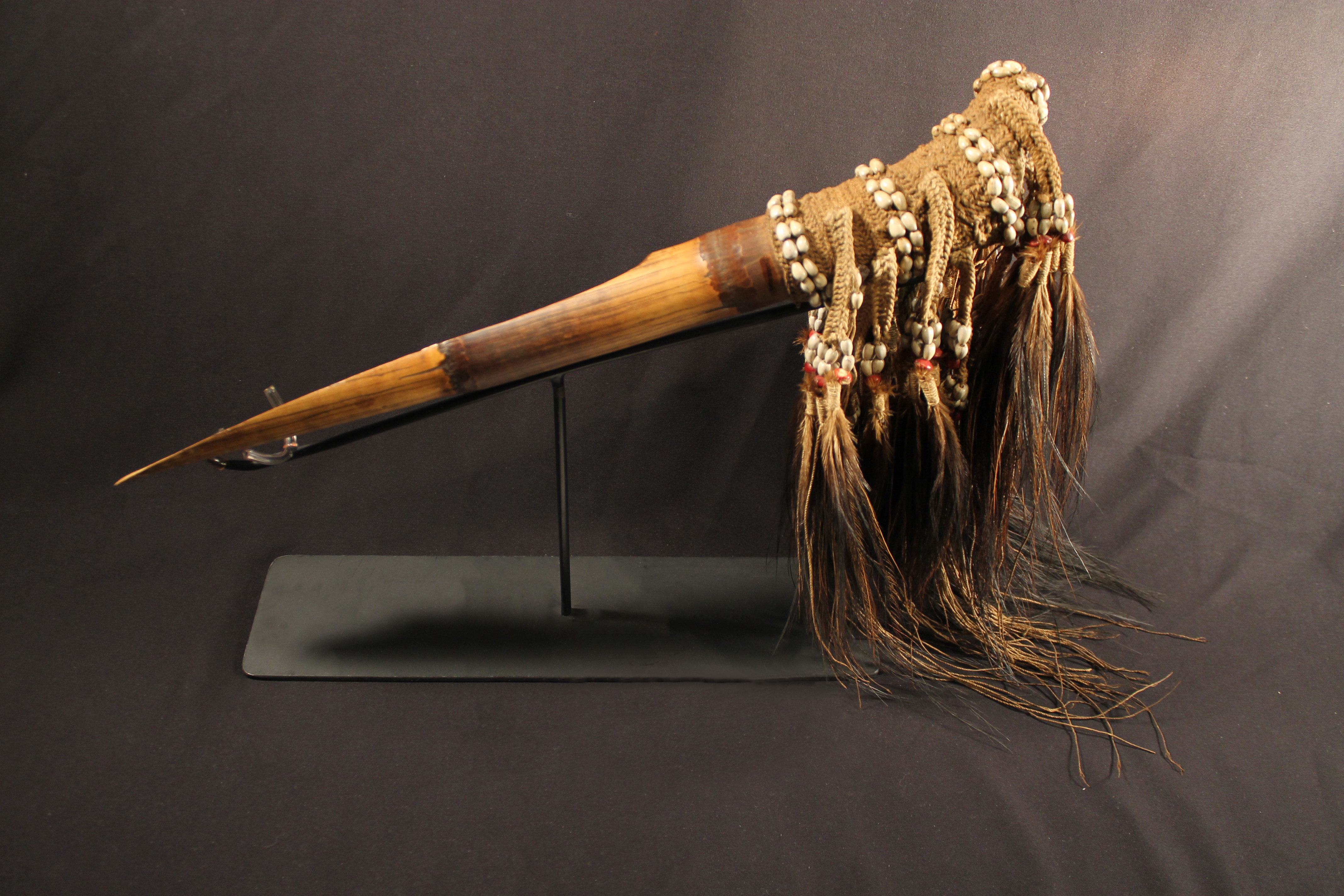
Knife
Amanamkai-Awok-Jeu/Indonesia, Becembub/Oceania
Bamboo knife, wood, crochet cord with seed beads, red seeds, feathers
Ceremonial knife, possibly used for human sacrifice or headhunting ritual.
Donated by Barry & Paula Downing
2001.10.0216 Lowell D. Holmes Museum of Anthropology
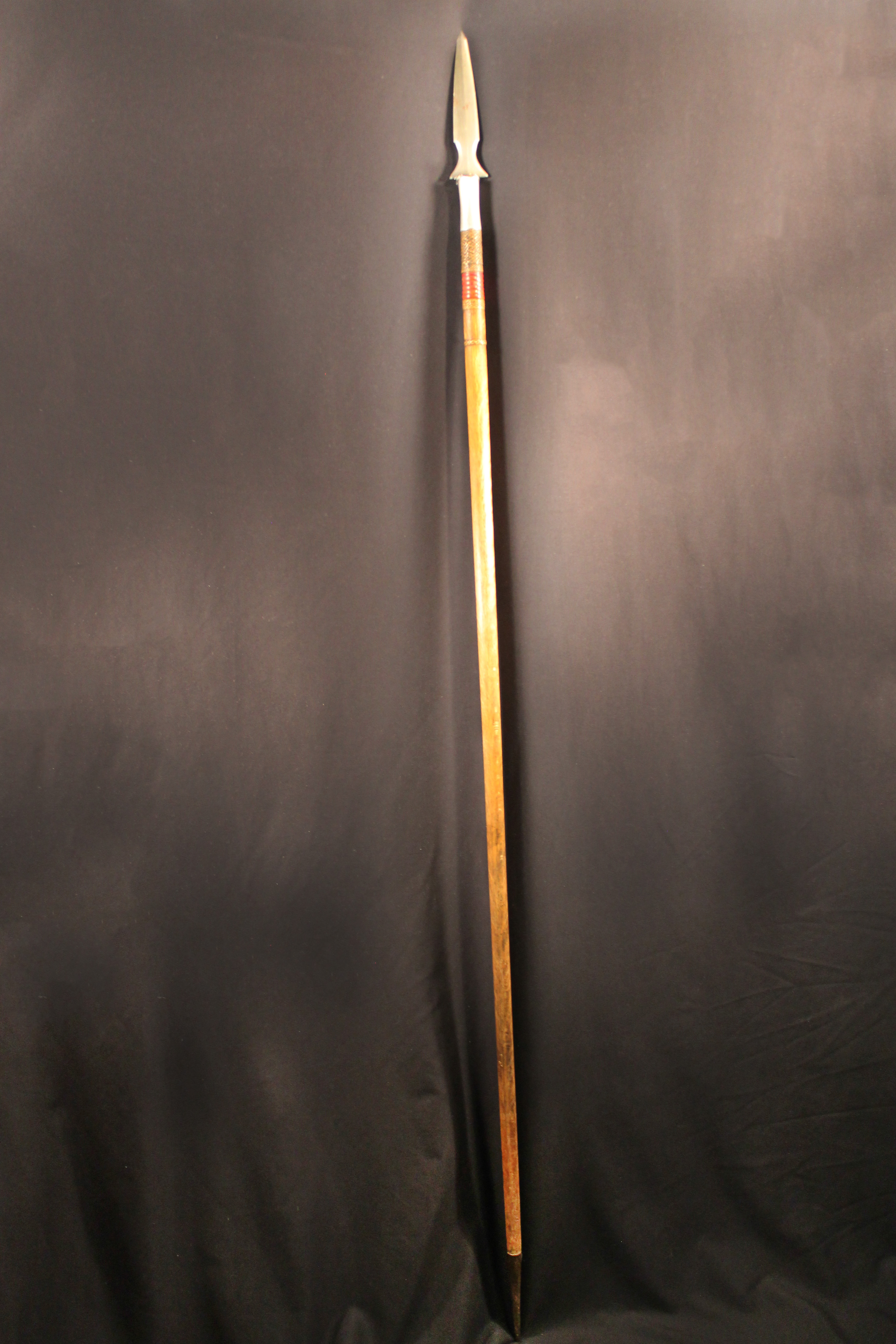
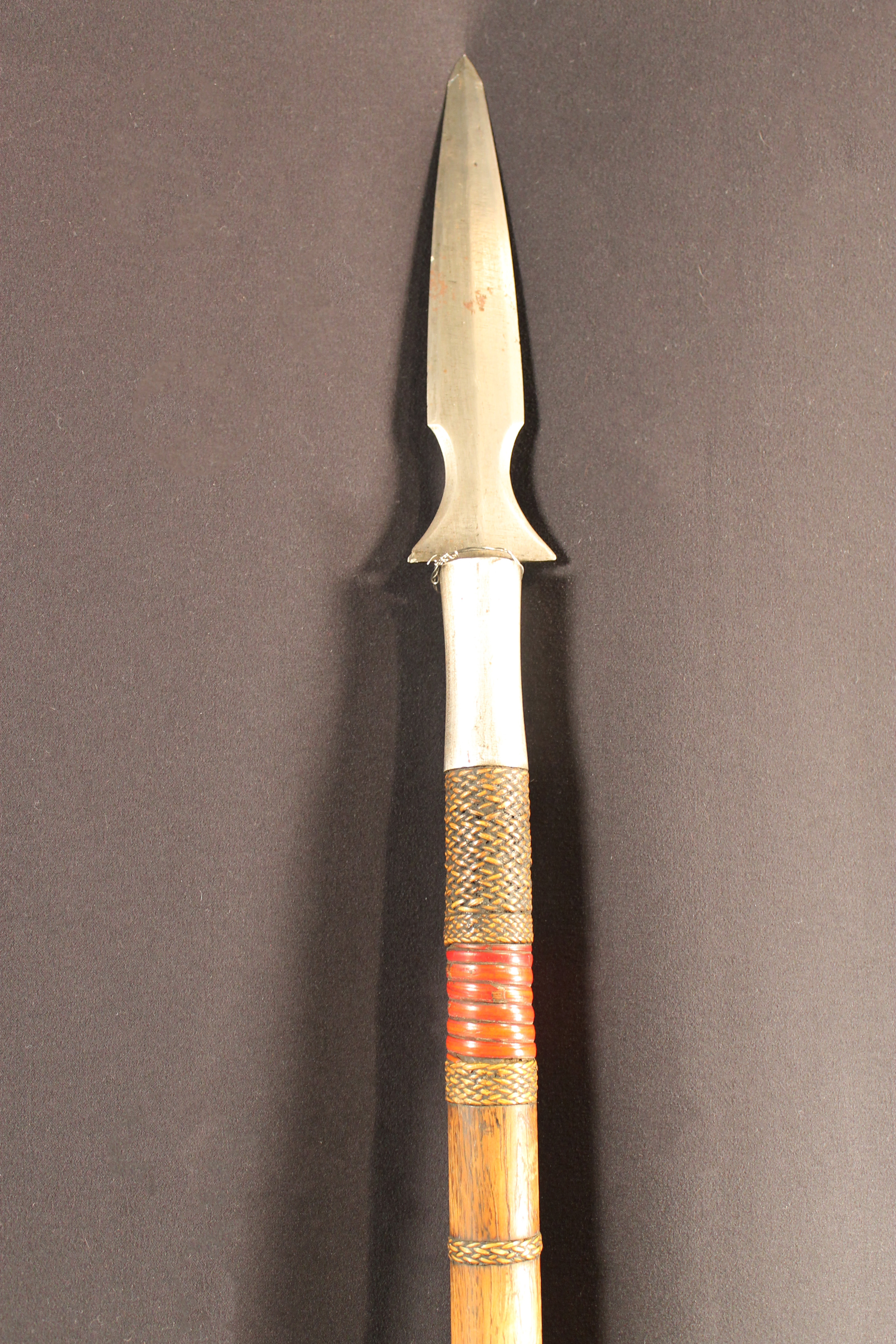
Spear
Philippines/Asia
Wood and metal spear, braided plant fiber, red plant fiber, braided plant material.
“Sibat” is the general Filipino term for spear. Spear hunting was versatile, being used in war and in hunting small and big game throughout Europe, Asia, and the Americas, among other areas of human inhabitants.
Donated by Rev. Leonard A. & Mrs. Dale Sr.
2015.06.17 Lowell D. Holmes Museum of Anthropology
Knife and Sheath
Philippines/Asia
Knife with several bands of braided plant fiber. Wooden Sheath, carved decoration, band of braided plant fiber and fiber rope.
Most likely used for a variety of tasks such as skinning animals,
Donated by Rev. Leonard A. & Mrs. Dale Sr.
2015.06.042a & b Lowell D. Holmes Museum of Anthropology
Mind
Indigenous cultures across what is now the United States made use of mind-altering substances during rituals. These ritual objects represent three Native American cultures: the Iroquois culture of the northeast, the Indigenous Peoples of the Great Plains, and the Ancestral Puebloans of the southwest. The False Face society of the Iroquois was an organization of medicinal practitioners that used tobacco and other smokes in healing rituals, and placed great importance on dreams. Tobacco smoke was also used by Great Plains cultures in a wide variety of ceremonies and rituals, but in particular, it is used in vision quests, a ritual where individuals seek a vision or visitation with the spirits though fasting, isolation, and tobacco use. The Ancestral Puebloans and other cultures used black drink, a highly caffeinated tea made from the holly plant, in rituals of purification.
Pipe Bag
Great Plains
Leather
Pipe bags were traditionally made with great care by women for men. They were considered a symbol of prestige as well as an object of fashion. This bag would contain the pipe stem, pipe bowl, and tobacco.
Donated by John L. Kiser
2004.02.002 Lowell D. Holmes Museum of Anthropology
Pipe Bowl
Great Plains
Stone
Pipe smoking of tobacco is an important feature of many rituals in indigenous cultures of the Great Plains. Smoking tobacco was used as a symbol of a binding agreement between groups, or to reach out to spirits and the supernatural in rituals like vision quests.
Donated by Charles M. Jackman
2002.08.009 Lowell D. Holmes Museum of Anthropology
Mug
Ancestral Puebloan
1150-1300 CE
Clay
The Ancestral Puebloans are a prehistoric culture that lived in the American southwest. As there are few oral histories of Ancestral Puebloan culture, anthropologists must extrapolate details of their culture from the objects left behind like pottery or their famous cliff dwelling structures.
Transferred from the Ulrich Museum of Art
1994.08.034 Lowell D. Holmes Museum of Anthropology
Mug
Ancestral Puebloan
1150-1300 CE
Clay
Mugs such as these were used in the consumption of black drink, a heavily caffeinated beverage made from cocoa and the Yaupon holly plant. Black drink is six times more caffeinated than coffee and was used in purification rituals.
Transferred from the Ulrich Museum of Art
1994.08.035 Lowell D. Holmes Museum of Anthropology


